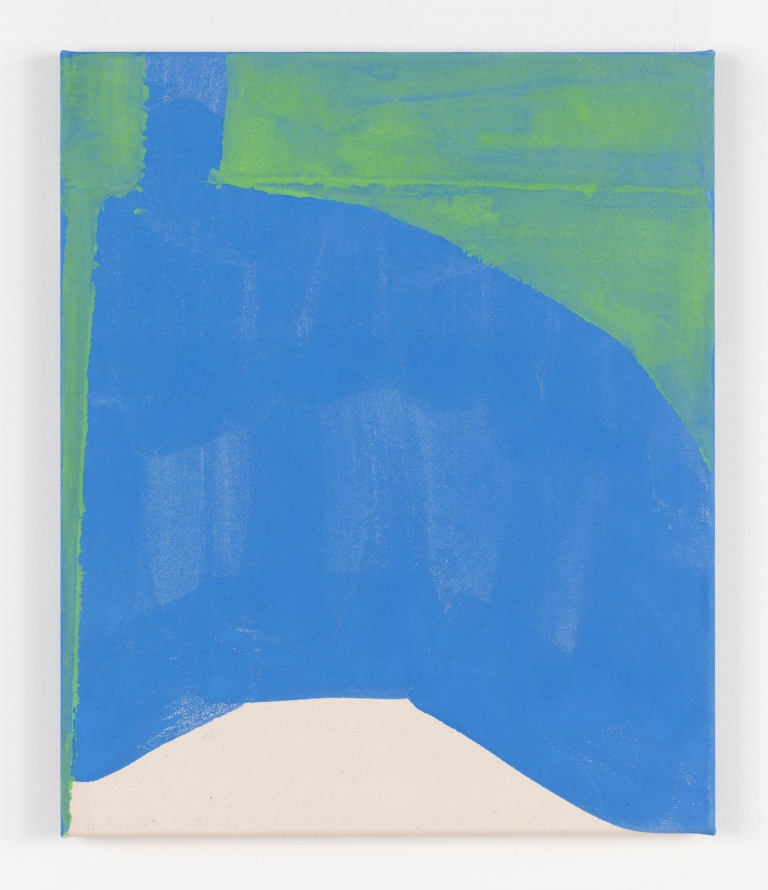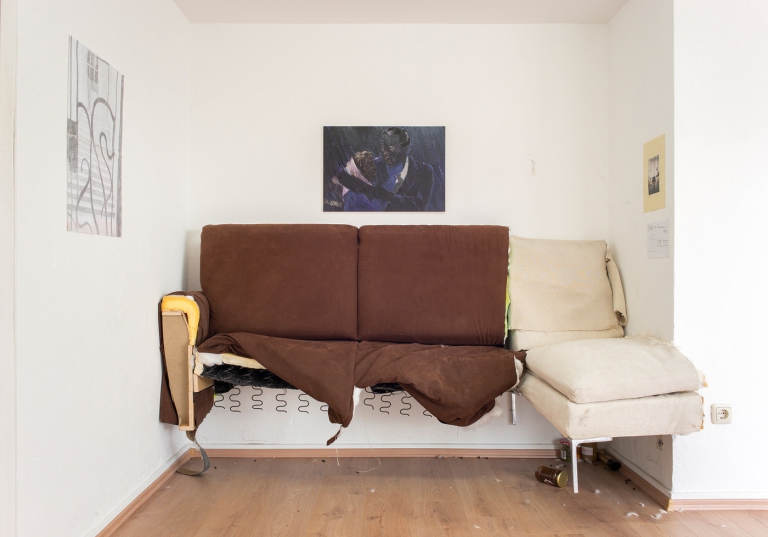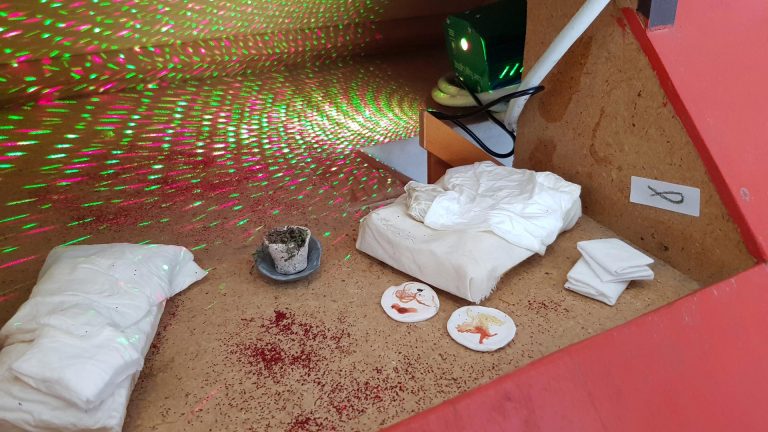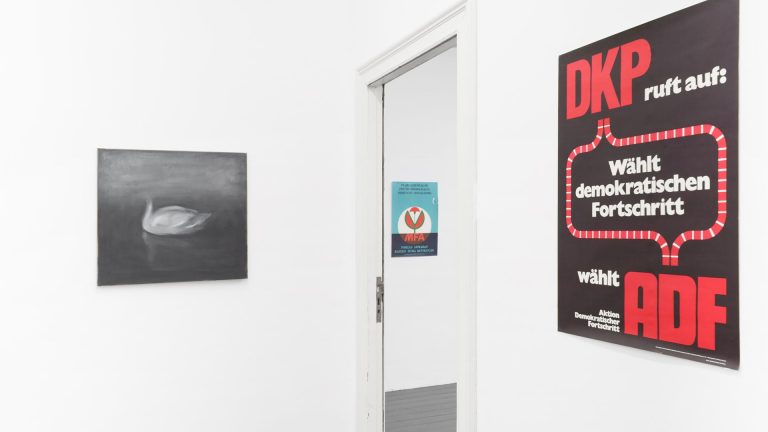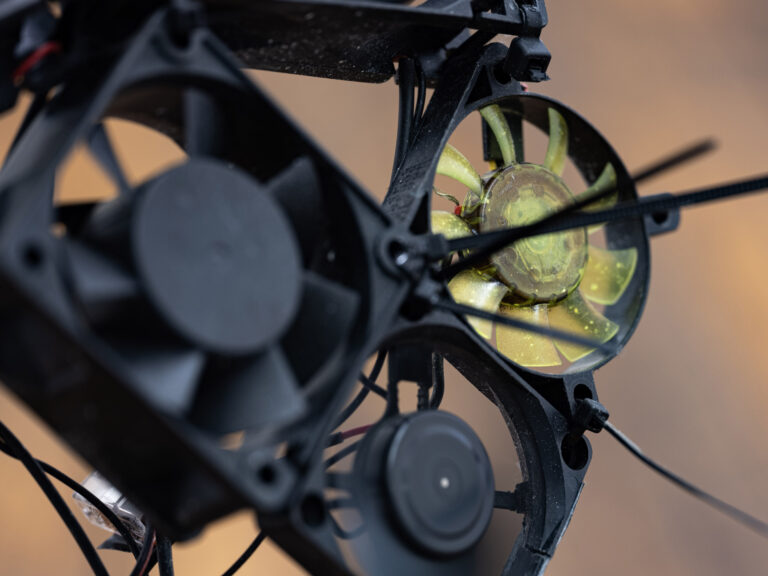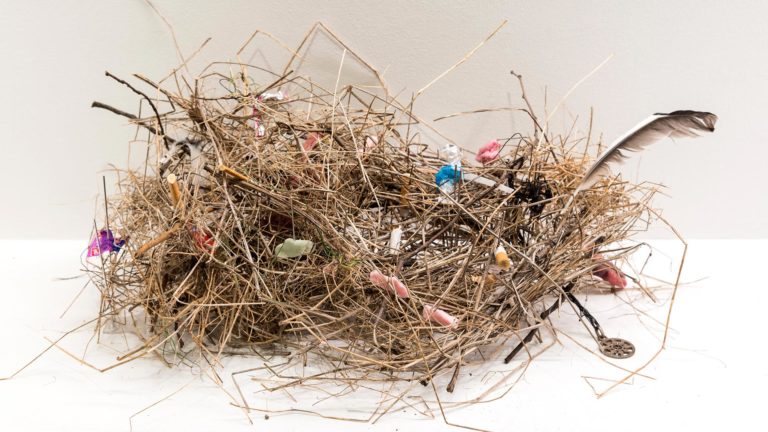Artist: Andréa Hygino
Exhibition title: Classroom (Sala de Classe)
Curated by: Victoria Tarak and Katharina Klang
Venue: Kunstverein Bielefeld, Bielefeld, Germany
Date: May 18 – July 21, 2024
Photography: all images copyright and courtesy of the artist and Kunstverein Bielefeld
The Kunstverein Bielefeld is delighted to present Classroom (Sala de Classe), the first institutional solo exhibition by Andréa Hygino (b. 1992, Rio de Janeiro, Brazil) in Europe. Like the Kunstverein, which is located close to two schools, the exhibition’s title also highlights proximity to a site of education: the classroom. Densely interpenetrated by social, societal and political factors, classroom spaces hold out the promise of a democratic sphere of action. But to what extent do actual school experiences reflect this promise? And how much is our answer to that question influenced by the position we speak from?
A recurring starting point of Andréa Hygino’s work is the critical examination of school, including the associated experiences of structural racism and classism. Through a close view into Brazil’s public education system, the artist looks at the micropolitics of forms of colonial thought and action which persist in the classroom, interrogating different forms of normalization and domination as well as transformation and participation. The artist’s works intertwine childhood memories of the school her mother founded with her own present-day experiences as an artist and teacher. The photographs, video works, installations, drawings, sculptures and texts exhibited in Classroom (Sala de Classe) are informed by processes of learning and unlearning, by student protests in what is called the “Global South” and by language as a cultural technique of decolonial practice. Hygino’s works confront the link between educational pedagogy and the conditions of colonialism. They facilitate a conversation about the responsibilities which this entanglement brings with it.
The ambiguous title Classroom (Sala de Classe) refers to both the space in which a school class takes place and a framework in which social asymmetries are actively reproduced. In fact, in Brazilian Portuguese, a “school classroom” would be translated as sala de aula. By deploying a deliberately incorrect word-for-word translation from English, the name Sala de classe heralds a linguistic attempt to reveal power structures lying “between the lines”.
Which classroom methods and practices are inscribed in students’ bodies?
Andréa Hygino’s engagement with the school environment goes by way of the body. Her work examines how the body is influenced by power structures, as well as the knowledges which the body can sustain and transmit. The recurring image of the open mouth – speaking, eating, chewing – symbolically marks the mouth as a place of empowerment. Hygino’s works present exercises in speaking (in fact: speaking back), marking a movement from silence to speech. These works also point out the political significance of food and digestion, specifically in connection with education. In the photographic works Tipos de Comer (Types of Eating) the focus on the mouth makes reference to living conditions indelibly marked by economic precarity. Video works like Exercício para a língua (Exercises for Language) and Gevaar (Danger) exhibit modes of subversion in relation to language and protest. In a lesson focusing on cognitive processes, bitten pencils from the series Mordido (Bitten) are presented as an outlet for bodily actions by pensive students. The more force is exerted on the pencils, the deeper the bite marks go. Along with the sociological-conceptual point of view, these marks allude to the artist’s expanded range of sculptural processes, which include removing material and leaving traces. The prevalence of traces also hints at the particular importance of printmaking for Andréa Hygino’s artistic practice. This medium highlights how her work is a practice of ongoing knowledge production, which goes hand in hand with the creation of informal archives. What is produced is an expanded understanding of what engraving on a surface and making marks in a medium can mean as processes. This context recurs in particular in the piece Prova de Estado (Proof State), which makes prints of school desks, their surfaces densely covered with incised markings. Here we see expressions of love, warnings and curses, a communication which runs parallel to lesson: the kind of comments and signs found on school desks all over the world. This surface can be seen as a kind of anarchic free space, an autonomous zone within the classroom. In the exhibition, the works face an entrance to the building across the street, which is used by pupils as a meeting point (for a secret cigarette or a private chat) between school breaks.
Digestion and education
Returning to the previously mentioned works Tipos de Comer (Types of Eating) the photographs show words literally lying on the artist’s tongue, made up of letters from the noodle soup commonly found in school cafeterias in Brazil. The work here makes reference to the closure of Brazilian schools during the Covid pandemic, which meant children lost the lunch which is normally freely available to them. For many children from economic poor backgrounds, this lunch is one of the few meals they eat in a day. The Brazilian Portuguese words for “rice,” “meat” and “beans” denote staple foods in the country, foods that are in short supply in many households affected by hunger.
The installation Poemas para ler de boca cheia ou Jantar para Carolina (Poems to Read with Your Mouth Full, or Dinner for Carolina) increases our visual sensitivity towards school as an institution which nourishes the mind and the body. Rather than plates and cutlery, the table here is set with exercise books, across which noodle-soup letters have been scattered, creating recurring lyrical connections. The letters here recall the forms of concrete poetry, illustrating the connection between poetry, installation and working with materials from a school environment. Here, the exercise book becomes a site of a poetic arrangement where the artist can play with emptiness and fullness. The letters are formed into small-scale architectures; they can be read as a metaphorical image, one which reinscribes a formulated statement about weight and weightiness. Other exercise books address “being nourished” as a human right – to be sated with food or knowledge – but also having to learn on an empty stomach.
As the title refers to Andréa Hygino dedicates her installation to Carolina Maria de Jesus (1914 -1977). Jesus is one of the most important Brazilian writers and poets. With her work, the Afro-Brazilian author raised awareness of social inequalities and the meaning of hunger within the country.
During a residency stay at the JA.CA. Centro de Arte e Tecnologia in Minas Gerais, Brazil Andréa Hygino turned the residency’s kitchen into her studio and later her classroom. Here she developed an art-education workshop for children from a local school, which included baking bread in the form of letters. The video work A-e-i-o-u shows the artist eating the alphabet similar to the ones she had baked with the children, an action which can be understood as a symbolic transformation of knowledge. To take this idea further, the mindfulness with which Hygino eats the bread creates attention to a process of the indigestible possibly turned into a form of self-care in the future. The work unfolds an artistic practice interwoven with pedagogical thinking.
The connection between words, food and sculpture can also be found in the works of Carne Verbo (Meat Verb) and Escreveu, não leu o pau comeu, where the artist interrogates the connection between the body, violence and education. The shape of this wooden piece is reminiscent both of cutting boards and of folding school desks. Through the physical form of these works, as well as the associations they bring up, including the imaginary act of cutting, Hygino addresses the overlap between the physical experience and the verbal forms of violence in schools. The Brazilian Portuguese expression Escreveu, não leu o pau comeu translates as: “If you don’t do what you’re supposed to, you, you’ll get into trouble.” The phrase addresses the experience of pressure to perform and the existential fears which go along with the promise of a successful passage through school to graduation.
Chair, Body, School
Chairs frequently appear in Hygino’s interrogation of the body within the school system: both as an object and a piece of furniture, the chair has intimate connections to the learning body, including forms of determining the bodies relation to itself and it’s enviroments. Produced by means of repeatable instructions, the (chair) works on display in Bielefeld are new iterations of existing sculptures by Hygino, which refer to site-specific furniture models and sites of education. In Saída de emergência (Emergency Exit), the back of a chair becomes a towering ladder, evoking both the promise of equal opportunity – “education will help you get ahead” – and the desire to escape the classroom. Ensino Superior (Higher Education) addresses the question of the inequality arising from fundamental needs not being met. This piece consists of a chair and a very small, inaccessible writing surface, a surface which refuses to become a site of articulation. The folding elements installed on both sides of the work Ambidestra (Ambidextrous) push back against the standardization of school furniture, which may, for example, only accommodate right-handed people. The sculptural work Descansologia (Relaxology) responds to the lack of free spaces for recreation and regeneration in economized educational contexts.
Other works by the artist consider the chair in connection with forms of protest. The group of works which make up Como usar uma carteira de escolar (How to Use a School Desk), are based on Hygino’s research into the 1976 Soweto uprising, a crucial protest
movement against apartheid South Africa, largely led by black schoolchildren. The demonstrations at that time were directed against the apartheid government’s order to teach school classes in Afrikaans, the language of the Dutch colonizers. The ongoing series Como usar uma carteira de escolar is based on photographic documentation of the Soweto protests from 1976, along with Hygino’s close-up observations of contemporary school protests in her own country of Brazil. Brazilian student protests against underfunding of public education have also adopted the chair as a symbol, as well as a practical device to use against state violence. Chairs are piled one on top of the other to form barricades. This is the background to Estudo para um cadeiraço (Study for a Barricade) for which Hygino designed an inkstamp with a chair motif, an extension in graphic form of the work’s larger-format version. In a school context, an inkstamp functions as part of the repertoire of bureaucratic gestures. But here, in Andréa Hygino’s compositions, the form is transformed into a playful multiplication of an act of resistance.
Language, Colonialism and Protest
As well as addressing education systems, Andréa Hygino’s work deals with the language loss which follows in the wake of colonialism. The video work Exercício para a língua (Language Exercises) which Hygino developed during an artist’s residency at Bag Factory Artists’ Studios in Johannesburg focuses on her mouth as it enunciates words in isiZulu, Sesotho and Tshivenda, some of South Africa’s surviving indigenous languages. For Hygino, the work is the documentation of a process of learning. At the same time, the actions performed in the video create a connection between groups which have been able to preserve their languages and people in the diaspora who have lost their native languages. Hygino’s work here resonates with broader postcolonial interests in linguistic diversity and orally-transmitted knowledge. In a way that connects with Exercício para a língua (Language Exercises), the video piece Gevaar (Danger) shows a speaking exercise which goes beyond language learning in any simple sense. What is at stake here is the pronunciation of a politically-loaded word. We see a mouth form the word “Gevaar,” which translates to “danger” in Afrikaans, a colonial language in South Africa. In her text Pretagogias, the chair, the uprising, the ginga, Hygino points out that the name of Afrikaans is misleading, since it is not an African language, but a mixture of different European ones, above all Dutch and German. The repetition of the word “Gevaar” here utters and reveals a violent process whereby language is used as a tool of colonization, a process continuing to this day.
The body in Hygino’s work tends to appear in the context of repetitive disciplinary processes at school. In an early work entitled Exercício de destreza (Dexterity exercises), the artist repeatedly wrote out the phrase Devo desenhar com destreza (I must draw the right way). Here, as a left-handed person, she painstakingly copied out the sentences, strictly adhering to the lines of the exercise book, in an attempt to “normalize” herself in the direction of right-handedness. As the title Desenho de pauta à mão livre (Freehand lines drawing) suggests, the drawing here was made freehand. Here, the lined school exercise book is set into motion, as the drawing becomes a moving sea of notation, reminiscent of musical staves. These create an association with the auditory, which can be linked back to the forms of empowerment articulated in the video work of A cadeira, o Levante, a ginga (The chair, the uprising, the ginga). The video work shows the artist together with her teacher (mestre) during a Capoeira Angola practice session. In the course of its development, capoeira was created by enslaved people in colonial Brazil as an instrument of defence and describes a multifaceted Afro-Brazilian oral cultural technique and body-related resistance practice, which is formed by combining dance, fight and music, among others. Against the backdrop of the Bauhaus architecture of the university where the artist teaches, the video work documents the artist’s movement research, which gives her access to pedagogical models that involve the entire body.
During preparations for the exhibition, Andréa Hygino held a number of art-educational workshops in collaboration with local schools, like the Laborschule Bielefeld and the Westkampschule Bielefeld, with a focus on hearing and communication. Some of the results of these workshops can also be seen in the exhibtion at the Kunstverein. The exhibition is also accompanied by visits from the Oberstufen-Kolleg and a working group of the Faculty of Education at Bielefeld University: WG 10 – Migration Education and Critique of Racism.
In addition, Andréa Hygino presents a site-specific work entitled Espaço livre para matar aula (Free Space for Skipping School), which has been developed in the exterior spaces of the Kunstverein, a piece which calls out “breaktime” as clearly as the recess bell from an actual nearby school. The second piece in the inner courtyard – entitled Domingos, Feriados, Rios e Marés (Sundays, Holidays, Rivers and Tides) – also refers to these moments of freely-available time. School uniforms hanging on clotheslines hung between trees bring to mind how clothes have previously been discarded, while also critically questioning the democratic promise of equal treatment.
The piece Cadeira Universitária (University Chair) expands the exhibition’s scope into the public spaces of the city of Bielefeld itself. Here, Hygino’s examination of how the chair relates to the body serves as starting point for a broader examination of the sitting postures decreed for interior and exterior educational spaces. By dismantling the elements of seating, the artist here calls into question how bodies are constantly invited to “take a seat.” By means of screen prints placed at various locations in the city, Hygino combines artistic modes of deconstruction with the kind of protest which proposes new and reorganized forms. The latter two works were firstly created in the context of Rio de Janeiro, the city in which the artist lives and works– and find site-specific translations into the context of Bielefeld.


Installation view, Klassenzimmer (Sala de Classe), Kunstverein Bielefeld 2024. Photo: Fred Dott








Installation view, Klassenzimmer (Sala de Classe), Kunstverein Bielefeld 2024. Photo: Fred Dott




Installation view, Klassenzimmer (Sala de Classe), Kunstverein Bielefeld 2024. Photo: Fred Dott


Installation view, Klassenzimmer (Sala de Classe), Kunstverein Bielefeld 2024. Photo: Fred Dott









Klassenzimmer (Sala de Classe), Kunstverein Bielefeld 2024.
Photo: Fred Dott


